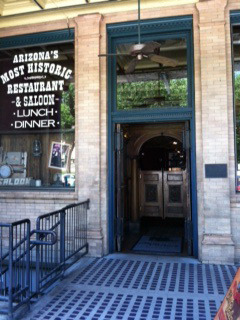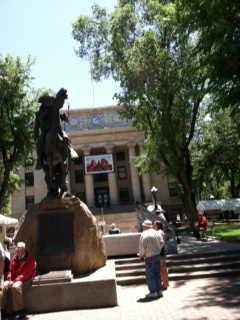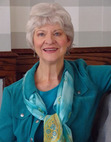Heidi M. Thomas's Blog, page 18
June 18, 2012
Show, Don’t Tell Part 2
Here are more ways to “show” rather than “tell” in your writing.
 5. Use the five senses: Sight, Sound, Smell, Touch, Taste. Not only describing, but using what the character sees, hears, smells, touches and tastes.
5. Use the five senses: Sight, Sound, Smell, Touch, Taste. Not only describing, but using what the character sees, hears, smells, touches and tastes.
6. Setting: Example: a love scene. Is sunset in a park more romantic than busy street corner? Where an action happens makes an impression.
7. Tension: I once attended a workshop where the instructor said there should be tension or conflict on every page. That doesn’t necessarily mean a big confrontation or fisticuffs, but something as simple as your main character feeling uncomfortable—too warm, too cold. Feeling out of place, clothing too tight, fidgety during a long lecture, etc.
Which of these openings would attract the reader more?
1. It was a spring day in 1974 when Tom and I were getting ready to sail up the Sound to Block Island. We had bought the boat the year before, but this was to be the longest sail we’d tried …
2. The cold dawn roused us from grainy sleep, and we stumbled from our bunks into the cockpit to stare at the open water of the Sound, less than a mile from the marina. The numbness we felt was more than the cold, it was the uncertainty of our sail to Block Island…
Example: If you write, “He was a gorgeous hunk.” What does that mean? Does that evoke any emotion  at all in you? That could apply to a lot of men. So maybe you write, “He was a tall, gorgeous hunk.” That’s also pretty generic. Doesn’t attract you much, does it?
at all in you? That could apply to a lot of men. So maybe you write, “He was a tall, gorgeous hunk.” That’s also pretty generic. Doesn’t attract you much, does it?
Show your hunk with powerful details of action, setting and body language. i.e. He ducked as he entered the room, the door frame barely brushing the top of his wavy black hair. Stopping to survey the room, he took a deep breath, his powerful torso stretching the seams of his black knit shirt.
The housewives clustered around the table stopped their chatter. Six pairs of eyes turned toward the door, coffee cups poised mid-way to their open mouths.
Watch for “telling” words: the “to be” verbs, especially was with an “ing” verb. Example: He was seething with anger. Show it in how he feels inside or how he reacts physically.
Also the word “felt”—She felt a great sadness come over her. How does that actually FEEL? When you come across that usage, stop, close your eyes and remember a time you felt sad. Live through that moment again. Paint a picture of it in your mind. What do you see? What do you smell or taste? What physical things did you feel in your body? What triggered your reaction?
What else do you use to “show” rather than “tell” in your writing?








June 15, 2012
Show, Don’t Tell
We’ve all heard this advice, but what does it mean and how do we accomplish it? I will share some of the ways here:
 1. Emotion. Liking or disliking, feeling good or feeling bad about something. How a person reacts (physically and mentally) to a circumstance. Emotion gives a character direction. The character cares about something. He reacts to something that affects it.
1. Emotion. Liking or disliking, feeling good or feeling bad about something. How a person reacts (physically and mentally) to a circumstance. Emotion gives a character direction. The character cares about something. He reacts to something that affects it.
It’s not as simple as just telling us that your character has a certain emotion—the character has to arouse emotion in us as the reader as well. That is empathy. We are pre-conditioned to react to certain things in a certain way. Death, sex, frustration, potential danger or humiliation evokes feeling in us.
So if we’re reading about a character’s reaction to one of those things and it reminds us of our own experiences, we identify with that character. It’s a “Yeah, Me Too” kind of feeling. Then you feel like you can root for this person—you’re on the same side. Even the bad guys have a sympathetic side.
Example: From David Baldacci’s Hour Game: A serial killer has been keeping law enforcement puzzled, using a different MO with each murder. Clearly, this is a cold-blooded sociopath.
He took off his hood as he drove away. Then he did something he’d never done before. He drove directly to the home where he’d just committed perhaps his most heinous crime of all. The murdered mother was in her bedroom. Tommy was in his—the third dormer window from his left. The kids got up at seven to be ready for school. If their mother wasn’t up by then, they’d go and get her. He checked his watch; it was one o’clock now. Tommy perhaps had six more hours of normalcy. “Enjoy them, Tommy,” he mumbled to the dark window. “Enjoy them … And I’m sorry.” He drove off, licking at the salt of the tears sliding down his cheeks.
Stages of emotion:
A.Physical reaction—how the body feels
B. Behavioral response—something you do whenever a certain thing happens. For example: you stub your toe—you hop on one foot, or swear, or sit down and cry.
C. Chosen response—How you decide to respond to situations, based on your background. How you experience emotion throughout your life. For example, when someone wants to argue with you, do you clam up and say nothing or do you become red in the face, your voice rises in pitch and you spew forth in a vehement lecture?
 2. Dialogue. If you write: Jane was angry. What do you feel? Do you identify with her anger? No? How about: “I hate you, you lily-livered spawn of a rattlesnake.” Rather than “telling” you she’s angry, I “showed” you with the words she used. In writing this, I don’t need to say, “You lily-livered spawn of a rattlesnake,” she said angrily. The words show the anger. Whenever possible, use action and re-action instead of taglines (said).
2. Dialogue. If you write: Jane was angry. What do you feel? Do you identify with her anger? No? How about: “I hate you, you lily-livered spawn of a rattlesnake.” Rather than “telling” you she’s angry, I “showed” you with the words she used. In writing this, I don’t need to say, “You lily-livered spawn of a rattlesnake,” she said angrily. The words show the anger. Whenever possible, use action and re-action instead of taglines (said).
3. Use behavior, gestures or action, to show the character’s inner feelings. Pounding the table. Stomping out of the room. Throw something at the lily-livered… spit, peer at him through narrow squinted eyes. Physical reactions are also great ways to show emotion. (internal—stomach clenches, cold chills, legs wobble, etc.)
4. Use Props or “Vehicles”. Using an object that reflects the character’s emotion. What she wears, carries and uses becomes part of her personality. Think of items you associate with certain emotions—a favorite song, picture, a food, or a certain scene. Note how hearing the song unexpectedly or seeing the sight will arouse a distinct mood in you. A better way to characterize than straight description of hair and eye color, height, weight, etc.
Example: Melissa’s eye color doesn’t show us much about her personality, but if she wears rhinestone catseye  glasses, or if she drives an old wreck of a car, or if her plaid skirt is held together with safety pins, that tells us much more about what kind of person she is.
glasses, or if she drives an old wreck of a car, or if her plaid skirt is held together with safety pins, that tells us much more about what kind of person she is.
Check back on Monday to see some additional hints for “Showing, not Telling.”








June 7, 2012
Love and Holsteins at the Corner Cafe
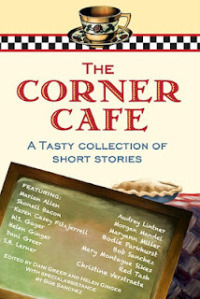 My guest today is Sherry Wachter, writing as Bodie Parkhurst. She and other members of the BBT Café group are on a month-long virtual tour with their anthology of short stories, Corner Café, available on Amazon for 99 cents. Learn more about this book at the Blog Book Tours blog. Bodie’s story is “Love Song with Holsteins.”
My guest today is Sherry Wachter, writing as Bodie Parkhurst. She and other members of the BBT Café group are on a month-long virtual tour with their anthology of short stories, Corner Café, available on Amazon for 99 cents. Learn more about this book at the Blog Book Tours blog. Bodie’s story is “Love Song with Holsteins.”
Welcome, Bodie. How did your story come about?
The roots of this story grew out of a past filled with dairies. My great-grandfather ran a dairy farm, which he passed down to my great-uncle, who also ran it, then got rid of the cows and just had a farm for years. The actual setting was built around a childhood visit to another dairy farm, where I played happily for hours with the little girl who lived there.
Russell (the bull) came from stories my parents and grandparents used to tell about a dairy farmer and his wife who did exactly what Maggie would like to do—they made their dairy bull into a family pet—even called themselves “Mamma” and “Daddy” to it.
He got his name from my sister’s cutting steer, which she used to practice for rodeos. She got him as a calf, but it turned out he was friendly. He loved her sons, and they loved him. Feeding time became play time, and of course it was probably inevitable that they named the calf Russell (because that’s what one does with cows) and trained him to ride. At that point Russell lost his value as a cutting steer—he no longer believed he had to run from horses. A steer like Russell is just too good to waste, hence the story. No life experience need ever be wasted.
Is your main character, Maggie, based on a real person?
Maggie is no one person, but a tribute to a lot of farm and ranch wives I’ve known—women who feed and care for their families, keep reasonably neat houses, keep everybody dressed, and yet spend huge parts of their days working outside—with the cows, in the fields or orchards, wherever there’s work to be done. These are women who rarely ever sit down—and yet they seem to carry a kind of graciousness that makes it hard to see how very hard they work, and how very much they do.
Bodie, I’m quite familiar with women like this—my mother was one.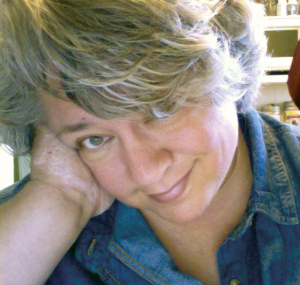
How did you get started writing?
When I was in college, my professor used to tell us to “write what we knew.” The truth is, I spent a lot of my life not knowing what I knew. I had a lot of experience, snippets of stories, but my family was the kind of family where there were a lot of secrets. Trying to understand our history was a little bit like crossing a creek by jumping from rock to rock—a story here, a story there, lots of dark water in between. And I definitely didn’t want to fall into that water.
What else have you written?
I’ve written a lot since then—a couple novels, several children’s stories, articles for historical magazines, a memoir, and I’m working on more memoirs, and a textbook. I’m also writing a music book for musicians who, for one reason or another, need a less complex, more linear form of musical notation, and I’m developing some of the art that I’ve done over the years for sale in textiles, housewares, clothing, and even, in one case, a painted memoir.
Bodie’s novels include Redeeming Stanley, (winner of Best of E-Books), a savage little tale of true love, old gods, bitches, bestiality, burnout, and above all, Payback; Good on Paper, 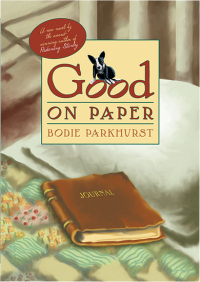 another book about ranch women who find themselves in a world where Americana has gone wrong—the “All-American” life they lead in rural America conceals a twisted, deadly core.
another book about ranch women who find themselves in a world where Americana has gone wrong—the “All-American” life they lead in rural America conceals a twisted, deadly core.
She has also published Past Lives: A Journey, a collection of short stories that grew out of what she says she later learned was an ill-advised foray into solo past-life regression, and Benchmarks: A Single Mother’s Illustrated Journal (available as both an illustrated book and as an unillustrated “text-only” book), a memoir about the journey from single life to motherhood.
Her picture books include: The Someone’s in the Kitchen Family Cookbook; Secret History, A Painted Journal: A series of captioned paintings documenting passage from abused child to happy, successful parent; Building Something Better: A story of a woman (Harriet) and her car (Betsy), and what Harriet discovers when Betsy breaks down; and The Very Good Dog: A character sketch of a farm dog with “Personality”—sometimes a little too much personality, maybe. Bodie’s books are available on Amazon.com
BIO: Bodie Parkhurst is a writer, artist, and designer. She lives in a Craftsman worker’s cottage named Betty in the empty half of Oregon, with her son Patrick, two formerly-feral Hawaiian cats, and a ghost named Jesús. She has a Master’s degree in English with a minor in Art, got through college by driving a truck and working in a dairy, and believes that no experience in life should be wasted. If nothing else, it provides plot material. She provides cover design, typesetting, and print coordination services to various small presses, and self-publishers.
Learn more about Bodie Parkhurst at her blog, where she shares news about her writing, her life, her projects, her printing house Magic Dog Press and her family recipes.
Please join the BBT Cafe group at the next stop: Monday, June 11 Marian Allen http://www.marianallen.com/








May 29, 2012
Finding ‘Prescott Blue’
Over Memorial weekend, my DH and I visited our future retirement home near Prescott, AZ (pronounced like Press-kit). When my sister-in-law was there with us a year ago, we coined the color “Prescott Blue,” which is like no other sky–often not a cloud to be seen, just clear, vivid blue. While Phoenix was 90 degrees, Prescott was 60-70, with a cool breeze. And, they boast 300 days of sunshine, while we in the Pacific Northwest have 300 days of clouds.
We ate lunch one day at the Palace Restaurant and Saloon, on “Whiskey Row” in old-town Prescott. Opened in 1877, it is the oldest frontier saloon in Arizona, and has hosted such famous people as Wyatt and Virgil Earp and Doc Holiday. On July 14th, 1900, The Palace was destroyed by the Whiskey Row fire. The ornately carved 1880′s Brunswick Bar, which is still in use, was carried to safety across the street to the plaza by patrons, and the saloon was rebuilt for $50,000 within the next year. The movie “Junior Bonner” starring Steve McQueen was filmed there in 1971 as was a scene from “Billy Jack” and “Wanda Nevada.”
Prescott Courthouse and park hosted a juried art fair through the weekend. Arizona is celebrating it’s 100th anniversary of statehood this year.
Prescott-area terrain. It’s not just flat sandy desert, but is at 5,400 feet at the base of the Bradshaw Mountains and has a population of 40,000. Chino Valley is a small rural town 16 miles north of Prescott and that is where we will be relocating upon retirement.
Our Chino Valley neighborhood.








May 16, 2012
Bursting into Spring
Spring literally blossoms with metaphors about rebirth, new life, and new beginnings. It is my favorite season and is especially meaningful to me.
One reason is because I grew up on a ranch in eastern Montana and celebrated the release of snowbound winters with warm sunshine, hills rolling with green grass and quilted with wildflowers, and I witnessed the birth of new calves.
Another reason is one I discovered when I moved to Missoula in the western part of the state. Missoula is located in the bottom of a mountain valley and in the winter, it experiences the same type of weather inversions as the LA basin. Because of this, although winters there are more temperate than eastern Montana, it is often cloudy for weeks on end. That is when I discovered that I suffer from Seasonal Affective Disorder (S.A.D.)
Now I live in the Pacific Northwest, where it is more often cloudy and rainy all winter than not. In spring, I feel like the tulip that flourishes here, reawakening after a long winter’s hibernation.
Like a tulip, I awaken
Reaching up toward the warmth
Straightening my curled-in body
Pushing away the heaviness of the winter soil
Like a tulip, I awaken
Stretching my arms to the sun
My eyes open as the petals
Squinting at first, then opening wide
Like a tulip, I awaken
Hearing the buzzing of the bees
Sensing the grass grow
Feeling the earthworms move
I am the tulip, as I awaken
Reveling in the sunshine
Embracing its glow, its warmth
I am the tulip, as I blossom in the spring








May 3, 2012
Creating Time in a Hurry-Up World
 By Marney Makridakis author of Creating Time
By Marney Makridakis author of Creating Time
Pay attention to the conversations of people around you, and notice how often the subject of time comes up:
“I’m fine, just crazy busy. . .”
“I just don’t know when I can find the time. . .”
“I can’t really talk now, I’m running late. . .”
People used to be tied to things like families, communities, rituals, worship, curiosity, and beauty. Now we are tied to schedules, watches, datebooks, computers, and keeping up with the latest gadgets that start with i. It seems like time is going by faster than ever these days, and we’re all exhaustively trying to find, chase, save, and manage time.
Time-management techniques, as well as the latest time-tracking and productivity aids, can certainly be of help to us on the practical level, but they are limited in their long-term effectiveness, since the true nature of time extends beyond the chronological hours displayed in our calendars, wristwatches and smart phones. Time management can improve what we accomplish but often at the peril of what we experience. Ironically, the more we desperately try to manage our time, the more fragmented we often feel.
Instead of exhaustively striving for time management, I propose a new solution of time metaphorphosis. Rather than simply managing our time, we can re-imagine time itself and completely reshape our relationship to it. When we don’t have time, we have to create it, and the incredible news is that we can do so with one of the greatest resources ever to exist on our planet: human creativity.
The concept of “creating time” is not just about adding more hours in our day, but creating a new relationship with time itself. We expand our sense of time by when we change the ways we think about, measure, and experience time.
Here are some good places to start:
Change the Way You Think About Time
For most of us, being stressed or worried about time has become second-nature. The most immediate way to change these deeply-ingrained patterns is to become more aware of the words that you use when you think about and talk about time. Time reacts as if we’re yelling in a canyon; whatever we are saying about time comes back to us in our experience. If we are saying, “There’s never enough time,” then our experience echoes back, “Yes! There’s never enough time!” If, however, we are saying, “I have all the time in the world. More and more, I see that I have all the time I need,” then our experience is reflected back with a more expansive, flowing sense of time.
Another simple way to shift awareness is simply to check the clock in a different way. The phrase, “What time is it?” inherently indicates that we do not have control of our time. By replacing this phrase with “What time does the clock say?” we take control of our time through the words we speak. The new phrase indicates that we respect the clock, but we are the ones in charge of our time.
2.
Change the Way You Measure Time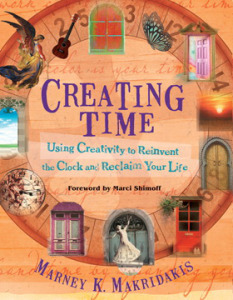
We measure time in linear fashion, with numbers on a clock and squares on a calendar to represent the movement of time. But what if we could interpret time as a qualitative entity instead of something just measured by quantity? Instead of measuring how long something takes, why not measure it by how much we learn by doing it, or how much love we are feeling?
Think about the moments in your life that have meant the most to you. Those moments are not viewed linearly at all, but through a plethora of other measurements, such as intensity of experience, emotional depth, and even quality of color or the particular scent of the moment. We can learn from these experiences by applying a similar free-form perception in our everyday moments. So, in your day-to-day life, instead of measuring how long something takes, explore new measurements, such as how much joy you feel, how connected you are to other people, how grateful you are, how engaged you are in the topic at hand.
Incorporating these new “measurements” doesn’t mean that we are forgoing the linear methods entirely. Rather, we remain aware of both kinds of time (quantitative and qualitative), but it is the qualitative measurements that are, in the long run, more important. Our sleeping hours are a great example of this duality. Most of us would prefer to get six hours of deep, restful sleep rather than nine hours of tossing and turning. While we can be aware of the number of hours we sleep and even plan our schedule to ensure that we sleep a certain number of hours, we are far more focused on the quality of the sleep that we have achieved. Similarly, when evaluating our time, we can be aware of the hours and minutes passed, but the quality of those moments is what really matters.
3. Change the Way You Experience Time
Instead of seeing time as something separate from us, true freedom happens when we become one with time, partnering with it in a new way. We can invite it into a relationship, a dance, so that we can fall into oneness. When we are truly at one with time, we reach a blissful state of being less aware of time itself but more aware of the present moment.
We can become more present through simple, easy actions. Expand the breadth of time literally, through deep breaths. Observe what each of your senses is taking in. Feel your feet on the earth’s floor. Express gratitude for all the “little things” that are easily taken for granted. Each of these is an example of a simple way to connect with the fullness of time.
Each moment you fully insert yourself in the present, you change your experience of time, shifting your focus away from how you spend time to instead reveling in what you receive from it.
Check out the Book Trailer for Creating Time.
Marney K. Makridakis is the author of Creating Time. She founded the Artella online community for creators of all kinds and the print magazine Artella. A popular speaker and workshop leader, she created the ARTbundance approach of self-discovery through art. She lives in Dallas, Texas. Visit her online at http://www.artellaland.com.
Based on the book Creating Time: Using Creativity to Reinvent the Clock and Reclaim Your Life ©2012 by Marney Makridakis. Published with permission of New World Library http://www.newworldlibrary.com








April 26, 2012
More on Finding Your Writing Voice
What is a writer’s “voice”? That is a question we all ask when we begin writing and maybe even after we’ve written for awhile.
In the words of Grammar Girl, Mignon Fogerty: “Voice is the distinct personality, style, or point of view of a piece of writing or any other creative work. Voice is what Simon Cowell is talking about when he tells “American Idol” contestants to make a song their own and not just do a note-for-note karaoke version. Many musicians have played “The Star-Spangled Banner,” for instance, but there’s a world of difference between the Boston Pops’ performance and Jimi Hendrix’s, even though the basic melody is the same.”
I want to also share a great interview with Les Edgerton on Kristen Lamb’s blog. Edgerton has a book out on the writer’s voice, FINDING YOUR VOICE: How to Put Personality in Your Writing.
He says there are at least three ways to tell if you have written in your true voice.
Are the Word Choices, Sentence Usages, and Phrases Employed Yours?
Sentence Structure: Do you talk and think in fragmented sentences? Then you should use these in your writing.
Clarity: The trick to writing well? Write simply; write clearly. Eschew flowery language.
To read the full article, go to Kristen Lamb’s Blog.








April 21, 2012
‘Testamentalism’ or Finding Your Voice
 My guest this week is Ken Rolph, who lives in Blacktown, Australia and is the author of Dog Tales.
My guest this week is Ken Rolph, who lives in Blacktown, Australia and is the author of Dog Tales.
He studied and worked at Macquarie University in science and later did computer work with large Australian companies. All along the way he wrote whenever he was able, for whatever outlets presented themselves. Then, having reached that fabulous place of wonder and delight, the Year 2000, he stopped and looked around. The kids were grown up, the major expenses paid.
He became an ex rat and retired from the race, setting out on a quest to see if he could write something worthwhile. His program of personal review and renovation has resulted in a collection of short writings, published as Dog Tales. If you ask him the serious question (what do you do?) he is likely to answer, “I contemplate the essence of things.”
by Ken Rolph
When I was but a lad and deciding to become a writer, I looked forward to the time when I would have mastered it all. The words would flow easily and without problems. I would find my authentic voice, my unique contribution. I would master both the craft and theart. Some time, when I got older.
Now I’m here and it doesn’t seem to work that way. Every piece of writing starts with that blank empty page. Sure, some things do get conquered. But new things crop up. There are problems that occur towards the end of a career as well as at the beginning. I’ve begun to appreciate that there are temptations and trials for the older writer.
The obvious one might be review and regret. We look back on our writing life and think about all the things we did and didn’t write. Missed opportunities. Laziness and slackness. Insufficient volume of production. I recognise this, but I’m not suffering from it. All this year I’ve had a severe case of Not Quite Dead yet and am not willing to close the book on myself. But when you get to the point in your life where you no longer measure how far you’ve come, but how far you have to go, what you do takes on a more urgent significance. That’s the trap I think is waiting for me. I’m going to call it Testamentalism. It’s the urge to deliver final, meaningful, significant statements about the Meaning of Life for the Edification of Future Generations. Now, sure, we do a bit of that all the time.
But I’ve been looking at the careers of several artists and can see a pattern. The earlier works are exploratory, light, episodic, lively. The later works become ponderous with Grand Statements. Characters disappear into Types and Archetypes.
I’ve been thinking about this for some time. A while back I bought a copy of the Eagles’ Long Road Out of Eden. It’s impressive. I enjoyed it. I appreciated it. The very last song is titled “It’s Your World Now.” It’s about passing over the world into the hands of a new generation. Which is what we have to do. The real thing about the Eagles’ album is that it is an Eagles’ album. It’s not really testamental. Part of the temptation is to do something different to what you have done in the past. As if what you did before was not what you really wanted to say. There can be a sudden lack of continuity in the art. A kind of desperation and resorting to the past and to “meaningful” art forms. It’s a bit hard to convey what I have in mind in regards to writers. You have to know their whole body of work. It might make more sense if I offer a few musical examples.
There are two CDs I’ve bought lately. Oddly, they are connected with a single song: Ain’t No Grave. The first is Tom Jones Praise and Blame. If you get a chance to listen to it you should understand what I mean by Testamentalism. I find the album quite hard to listen to. For me it doesn’t quite ring true. The other CD is Johnny Cash American VI: Ain’t No Grave. This is also an album made with finality in view. But it works because it is not a radical departure from Cash’s earlier work. It’s more of a fulfillment, a summing up, a full flowering. It brings not high art but profound art. The very last song is titled “Aloha Oe.” It’s Hawaiian in tone, but part of it is an instrumental riff. I found myself unexpectedly singing along to this as I recognised an old hymn, which goes “Then sings my soul, my Saviour God to Thee, how great Thou art, how great Thou art”. I’m sure that’s what it is, I’m sure it’s meant to be there.
So what am I going to do (aside from playing current music from the dead and dying artists of my youth)? My writing so far is mostly short, comic, light, domestic. I believe I need to go longer and more serious. But I don’t want to lose the tone that has come to be my own voice. Can I do this? Will being aware of the temptations to become ponderous and stuffy enable me to avoid this? I think that’s what I’ll have to try.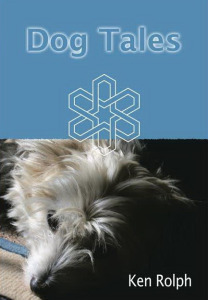
Dog tales aren’t just about dogs. Dog tales don’t pretend to be anything more than what they are: short tales about the everyday stuff of life. Whatever is happening in your life you can turn it into a dog tale. In this collection, there are tales about husbands & wives, pantries, tools, rats, pelicans, takeaways and compost, as well as an assortment of dogs. Dog Tales is an affectionate and humorous snapshot of life. http://www.buyaustralianbooks.com.au/book/kenrolph/dogtales/








April 17, 2012
St. Louis Arch: Gateway to the West
 St.Louis this weekend had nothing on Seattle as far as rain goes! It has poured rain in buckets most of the time I was there. But I managed to visit the famous St. Louis Arch.
St.Louis this weekend had nothing on Seattle as far as rain goes! It has poured rain in buckets most of the time I was there. But I managed to visit the famous St. Louis Arch.
The Arch is part of the Jefferson National Expansion Memorial, commemorating the Lewis and Clark expedition. It was completed in October 1965, and at 630 feet, it is the tallest man-made monument in the United States. Visitors can ride a “pod”-like tram (five seats, very cozy!) to the top and view the city on one side and the Mississippi River on the other. The tram takes one million visitors to the top annually.
In 1947 a competition challenged architects to design a memorial that would symbolize the dramatic story of westward expansion. Eero Saarinen‘s entry was the winner. It wasn’t built until the early 1960s and took two years. Workers struggled against high winds, biting cold and searing hear, along with dizzying heights and uneven surfaces. Saarinen died while undergoing an operation for a brain tumor at the age of 51 in 1961, before the Arch was finished. His other work includes the TWA terminal at JFK Airport, NYC, and Dulles airportWashington, D.C., and the General Motors Technical Center in Michigan.








April 15, 2012
Rockin’ out to Ted Nugent
I’ve been in St. Louis, MO this weekend, where my husband’s organization USPSA had a booth at the NRA Show. Many, many great people! Today I attended a concert by Ted Nugent, the “Motor City Madman.” Born and raised in Detroit, he formed the Amboy Dukes in 1965, and as a solo act has had a run of successful albums, including Free-For-All, Cat Scratch Fever and Double Live Gonzo! He is an avid proponent of hunting rights and the second amendment.
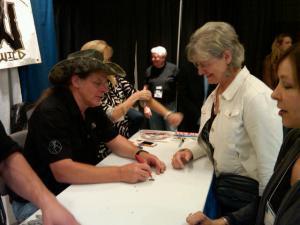
Getting Ted Nugent's autograph
Although I’ve never been a huge hard rock fan, I enjoyed the music today, and I even stood in line to get Ted Nugent’s autograph! It was a fun day in St. Louis.









